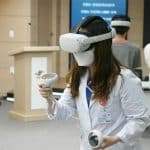June 7, 2021
Pedro D’Incao, an Apple Distinguished Educator from Brazil, provides a description of the theoretical reasons as to why we should incorporate augmented reality in education.

The case for Augmented Reality in Education
Undoubtedly, emotion and experience have a substantial influence on cognitive processes such as perception, attention, learning, memory, and problem solving. Numerous studies suggest that one of the keys to bringing information into long-term memory is creating emotional experiences that stimulate the brain and mark this information as meaningful.
Education experts have been developing numerous new solutions to maximize student engagement. In this sense, Augmented Reality (AR) has been identified as one of the most powerful tools for this task. A recent neuroscientific experiment, carried out by the Mindshare media agency, revealed the impact of experiences in Augmented Reality, since significant peaks in brain activity were observed in areas related to attention, memory and memory encoding.
It is worth clarifying that the latter is of the utmost importance since it allows the conversion of perceived elements into constructs that can be stored in the brain, either in short-term memory or long-term memory. In the brains of the users who participated in the research and who were subjected to experiments within Augmented Reality, the information had a greater impact compared to the participants who were stimulated with traditional videos.
RECOMMENDED: https://global-edtech.com/category/community/
Augmented Reality is a powerful tool to change behavior because through its ability to make the abstract seem real, it allows a real revolution from a cognitive perspective. In the social sphere, we also have several studies that show that experiences that incorporate virtual environments can even change behavior. Thus, the use of AR environments helps users to see, hear and feel the future and understand the negative and positive consequences of their actions as if they were occurring in real time. It is a powerful element capable enough of changing behavior immediately after exposure in a continuous and permanent way.
In the educational field, the fact of feeling the experience and emotion that Augmented Reality provides is a key and determining element to make teaching more meaningful and attractive. Activities with Augmented Reality have a high level of engagement on the part of students compared to traditional educational practices. Among the various benefits that AR offers we can mention:
– Provides a type of collaborative learning capable of involving students;
– Helps in the development of spatial skills necessary to understand three-dimensional objects (such as anatomical structures and spatial geometry).
– Stimulates curiosity and adapts to different learning styles.
Therefore, the need to incorporate Augmented Reality into our teaching practices is evident so that we can have efficient and stimulating results and students can experience the content delivered by teachers in an interactive, meaningful and creative way.
About Pedro D’Incao
With more than 20 years of experience educating teachers and students in the areas of Exact Sciences, and 17 years as Director of D’Incao Instituto de Ensino, Pedro has achieved the highest standards of STEM technology integration, acquiring the honor of becoming an Apple Distinguished School. His leadership in Apple for Education technology integration projects and Vernier teams has allowed his students and teachers to have incredible learning experiences.















0 Comments